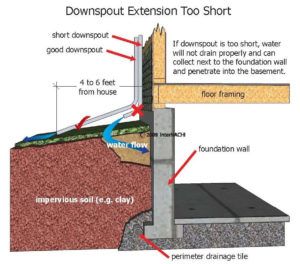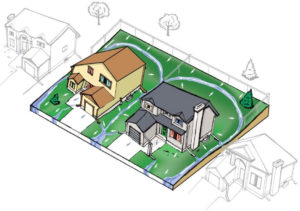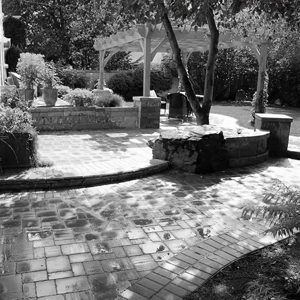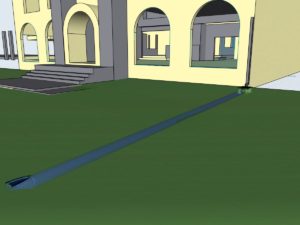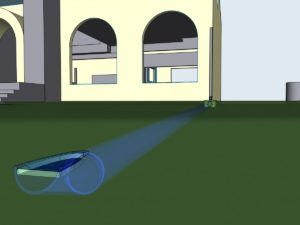Drainage Question Test
- Are you getting water into the basement of your house?
- Do you have any soggy or wet areas in your yard?
- Does your back yard look like a lake every spring or after a heavy downpour?
- Does ice build up along your sidewalk and/or along the side of your property?
- Do you notice dead grass patches where ice has built up over the winter?
If you answered yes to any of the above, you likely have landscape drainage problems. Drainage issues can be very stressful and if neglected can necessitate expensive repairs.
The most common contributing factors to poor drainage are:
- An improperly-graded landscape
- Inadequate management of your downspout and sump pump drainage
Less common factors that can contribute to poor drainage are:
- Compacted soil
- Poorly designed/installed fences
- Landscape features that impede water drainage
In simple terms, drainage issues occur when there isn’t a clear, sloped path for water to move downhill away from your home. An easy way to recognize a drainage issue in your yard is by the amount of time that water sits after a rainfall; if rainwater has not evaporated after 24 hours, a landscaping change is a must.
One of the biggest problems with unaddressed drainage issues is the potential damage to your house or other outlying structures. Water sitting against a building will cause materials to weaken and rot, and can lead to the development of mould. Excessive rainfall and/or standing water will seep down through the ground and through any cracks in your foundation, not only damaging interior features such as drywall and flooring, but also expanding those same cracks when it freezes. Unless you want extensive foundation repairs in your future, addressing drainage in the short-term is a much more cost-effective solution.
B. Rocke Landscaping Professional Solutions
Grading
An integral part of any landscaping project is good grading. All of your landscaping features should slope away from the foundation of the house, with different features typically having recommended slopes ranging from 1%-10%. Patios must slope away by 1-2%, whereas other softscape features can have a slope between 5%-10%, or even more.
Good grading is your foundation for good water management!
Managing Downspouts and Sump Pump Drainage
One of the most commonly overlooked elements to good drainage is managing the water flow from your downspouts and sump pump.
Adding longer eavestrough extensions (10’+) are an easy and quick solution, however they often get damaged or bent and can be an inconvenient tripping hazard over walkways.
A superior alternative would be underground Rain Drains. We recommend installing them in specific eavestrough and sump pump discharge areas.
A Rain Drain looks like this:
And functions like this:
A Rain Drain is a catch basin box that collects water from a downspout and/or sump pump and redirects it away from the building through a 4” underground drain pipe. Water exits the pipe further down slope, typically in a grassy area, garden, or swale. A sump pump discharge hose located in close proximity to a downspout can usually share the same drain box, but the 4” drain pipe then needs to be cut off within the property line (or wherever your local bylaws specify).
The 4” drain pipe is usually buried anywhere between 3-6” below ground, and as long as the discharge end is lower than the box the water will always drain properly. As with any water-bearing system, these drain pipes will freeze up in the winter. Rain Drains combined with a properly-graded landscape will give you the best possible water management system. Many people even take advantage of the extra water downstream of the discharge area to plant a garden of water-loving vegetation!
Author: Byron Rocke
For professional advice contact our studio b landscape design office at 204-615-2512 or follow this link and our expert team can help identify and provide solutions to your water drainage plan.

